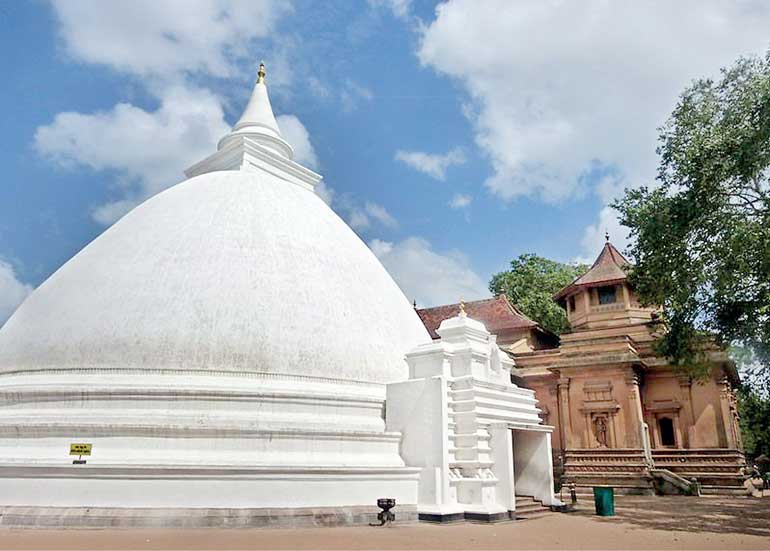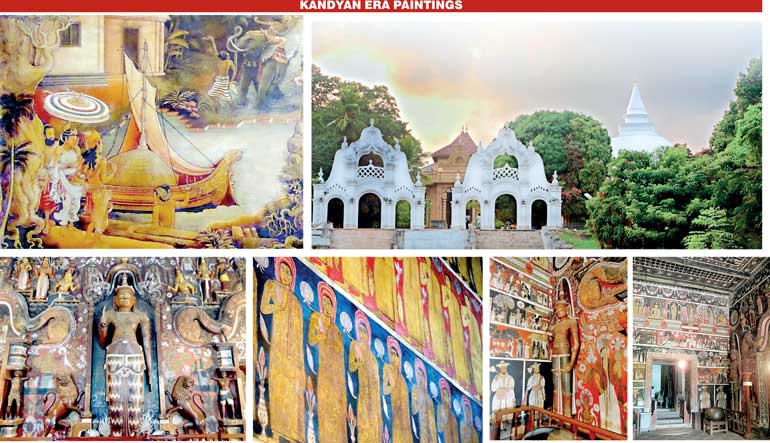Saturday Apr 20, 2024
Saturday Apr 20, 2024
Saturday, 30 December 2017 00:45 - - {{hitsCtrl.values.hits}}


By D.C. Ranatunga
The year is ending. A new year begins on Monday. 1 January 2018 is also the Duruthu Full Moon Poya day. The renowned Buddhist place of worship, Kelaniya being synonymous with Duruthu Poya, always draws devotees in large numbers. Coupled with it being the first day of the New Year, larger crowds will throng to the temple this time.
The high regard for Kelaniya among the Buddhists is seen by a popular anecdote which we have heard as children. Sung as a verse, it reads: Upan da sita karapu pavu netha – Varak vendoth Kelaniye. Though it claims that one’s sins will be washed away once the person worships at Kelaniya, it is a highly exaggerated statement intended to get devotees to go at least once and worship there.
Kelaniya has gained recognition due to the belief that it is one of 16 places in Sri Lanka visited by the Buddha. It is mentioned in the stanza recited to worship the ‘Solosmasthana’ (16 places) in chronological order. Mahiyanganang - Nagadipang - Kalyanam - Pada Lanchnam… the stanza begins. The first places mentioned are Mahiyangana, Nagadipa, Kelaniya and Sri Pada, where the Buddha has left his footprint. The Mahvamsa, the Great Chronicle records the Buddha’s visit to Kelaniya thus:
“In the eighth year after he had attained to buddhahood, when the Vanquisher was dwelling in Jetavana, the Master, set forth surrounded by five hundred bhikkhus, on the second day of the beautiful month of Vesäkha, at the full moon, and when the hour of the meal was announced the Vanquisher, prince of the wise, forthwith putting on his robe and taking his alms-bowl went to the Kalyani country, the habitation of Maniakkhika. Under a canopy decked with gems, raised upon the spot where (afterwards) the Kalyani cetiya was built, he took his place, together with the brotherhood of bhikkhus, upon a precious throne-seat. And, greatly rejoicing, the naga-king with his following served celestial food, both hard and soft, to the king of truth, the Conqueror, with his followers.”
It was the Buddha’s third and final visit to Sri Lanka, eight years after Enlightenment. The Buddha visited Kelaniya at the request of the Naga king Manakkhika. The dagoba in the shape of a heap of paddy was built by the king to commemorate the visit of the Buddha. A gem-studded throne which was offered to the Buddha to sit and preach the Dhamma had been enshrined in the dagoba.
Kelaniya has a chequered history over several centuries. It has been a sub-kingdom of the Anuradhapura kingdom when during the time of King Devanapiyatissa (161-137 BCE), his brother Uttiya had rebuilt the temple which obviously had been gone into rack and ruin.
Reference is made in a rock inscription of the Polonnaruwa period that King Nissankamalla (187-96 BC) had visited Kelaniya during a visit to a host of shrines in the country. The invasion by the Kalinga ruler, Magha in 1215 BE saw the temples being totally neglected. King Vijayabahu III (1232-36) who defeated Magha and ruled from Dambadeniya repaired the Kelaniya temple which had been improved with additional buildings by his successor, Pandita Parakrambahu II (1236-70).
The setting up of the Kotte kingdom in the 15th century is considered as the beginning of the golden era of the Kelaniya temple. Due to the close proximity to the capital, Kotte it was easy access for the royalty to extend their patronage. This was coupled with the renaissance of literature during that era.
The temple rose to fame as a celebrated seat of learning during the time of erudite chief prelate, Vilgamulla Sri Parakrama Sangharaja (1411-16). King Parakramabahu VI (1411-66) supported him by providing the necessary facilities. When ‘sandesa’ poems became a popular form of poetry, Totagamuwe Sri Rahula Thera (1408-91) got the bird to fly over Kelaniya and the temple is described in the book.
Extensive restoration work of the temple had been carried out by King Dharma Parakramabahu IX (1489-1513) who had been so fascinated by the beauty of Kelaniya that he had built a palace which had been used as a summer residence by later kings.
The domination by the Portuguese in the latter part of the 16th century led to the downfall of Kelaniya. Records state that the Portuguese captain Diego de Mello having defeated a battalion of Sinhalese troops sent by the king of Sitawaka in 1575 at Wattala proceeded to Kelaniya, looted the temple and demolished the buildings razing the temple to the ground.
The Dutch who followed the Portuguese did not allow Kandyan kings to restore the Kelaniya temple. Several requests were refused because of their policy of spreading the Christian faith. In 1770 a request by Kirti Rajasinghe (1747-82) had been granted and Ven Dehigape Attadassi, a pupil of Velivita Sri Saranankara Sangharaja had taken residence and started renovating the temple.
The early paintings seen on the walls of the old section of the temple belong to the Kandyan era (16th and 17th centuries).These are similar to the paintings seen in Dambulla, Lankatilleka, Sri Dalada Maligawa and other well-known temples in the hill country.
Recent times saw a complete renovation of the temple thanks to a single philanthropist, Helena Wijewardene. Having seen the dilapidated state of the temple during a visit she made in 1880, she immediately started work to restore the temple. A new wing was added and the old buildings were restored. New murals by the famous artist Soliyas Mendis soon won worldwide acclaim. The visitors are now able to see two different schools of art – the traditional Kandyan style and a modern approach.
To D.B. Dhanapala, the researcher of temple paintings, the Kelaniya temple murals “may be considered the best work done in Ceylon since the Polonnaruwa period (12th century AC), if not Sigiriya (5th cen. AC).”
The completion of the restoration work was celebrated with a Perahera in 1927 which continues to this day. The initiative to hold a procession in and around the temple precincts was taken by Don Walter Wijewardene, son of Helena Wijewardene.
